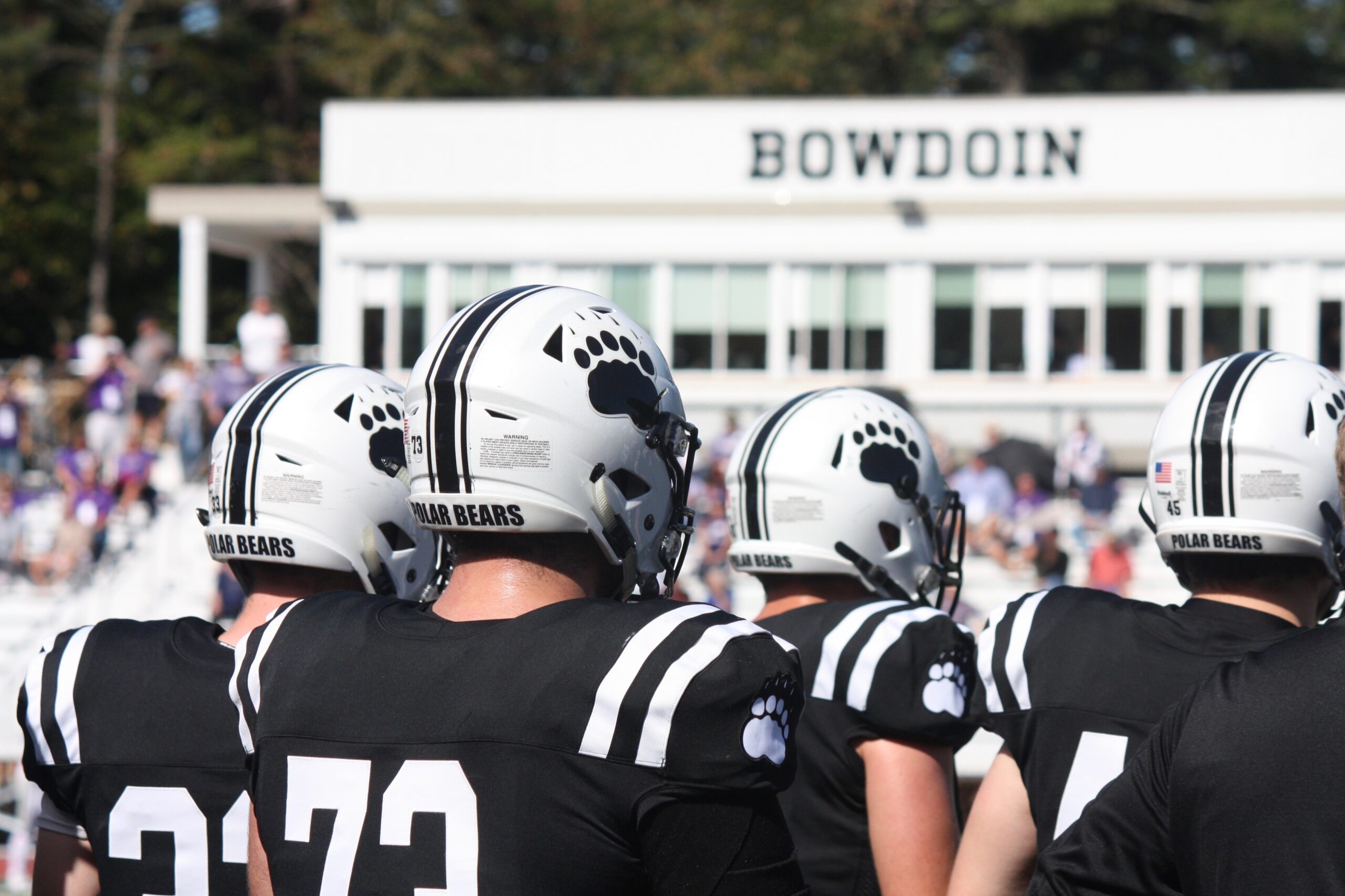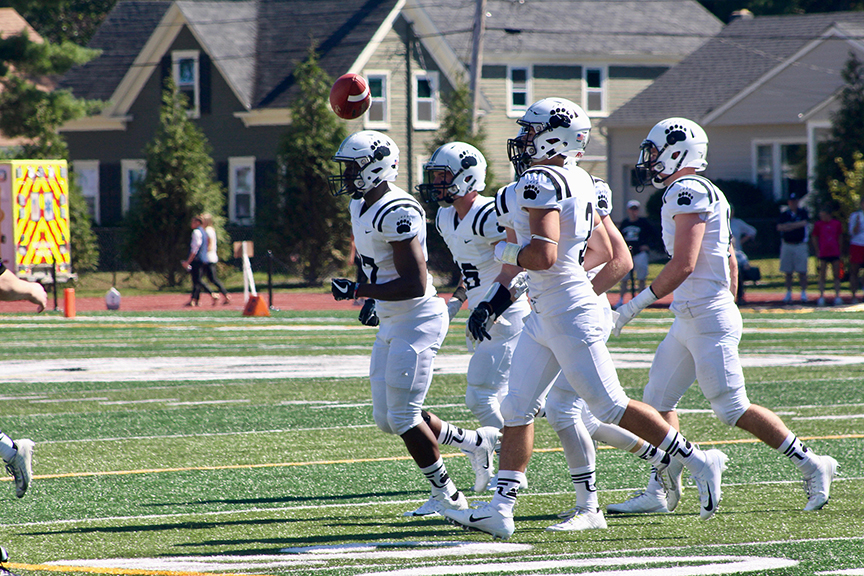With football team under new leadership, September is the time to believe
September 6, 2019
 Lauren Caffe
Lauren CaffeFootball has returned to Brunswick, and that means only one thing.
It’s Hammer Time.
Let’s all get up to speed. After using the first three quarters of last season to extend its losing streak to a record-setting 24 games, J.B. Wells’s Polar Bears managed to eke out one dramatic victory over Bates in the second-to-last game of the season. It was at night, under the lights. It was, at least in this writer’s mind, an exceedingly good time.
But apparently three wins in four seasons just doesn’t cut it for the higher-ups in Athletics, and Wells was sent packing in November with a 3-31 record to his name.
Enter, with appropriate fanfare, B.J. Hammer. The 41-year-old Indiana native made his name as the head coach at Allegheny College in Pennsylvania, where he transformed an uninspiring 1-9 team of Gators team into a respectable 6-4 program in just three short years.
Sound familiar?
The wager is that he can work his magic again, this time up north. To that end, Hammer has enlisted some of his compatriots from Allegheny: Braden Layer as the new offensive coordinator and Matt Cochran as the offensive line coach. Hammer, named a finalist for the American Football Coaches Association (AFCA) Division III Coordinator of the Year Award in 2014, will coordinate the defense.
There you have it: new coaches, new season, new prospects.
If only it were that simple. In football, it rarely is.
For a little insight into the uncertainties that linger over this coming season, let’s peruse some numbers.
The first is 17. That’s how many practices Hammer and his staff will have had between the beginning of pre-season training on August 24 and the season opener against Hamilton on September 14. Hammer hails from the mythical land of Spring Football—no such luck at Bowdoin. Whether 17 practices will suffice for Hammer to make any substantive changes remains unclear. What is clear is that the learning curve will be steep.
The second uncertainty also has to do with some basic arithmetic. Last season, Bowdoin’s offensive averaged 13.5 points-per-game (last in the league), and its defense averaged 34.2 points-per-game against (second highest in the league). If the White and Black want to put some more ticks in the win column, the team must—bear with me—score more and be scored on less.
And that will take improvement on both sides of the ball. In 2018, Bowdoin offense was eighth out of the 10 NESCAC teams in total offense, eighth in first downs, 10th in third-down conversions and 10th in red-zone offense. In other words, eh.
Hope for a turnaround lies with the offensive triad of quarterback Austin McCrum ’21, running back Nate Richam-Odoi ’20, and tight end Bo Millet ’21. Fresh off transferring from Division I Lafayette College in 2018, McCrum never really found his stuff in Brunswick. He ended the season with the worst passer rating of any starting quarterback in the NESCAC (85.6), and he threw more than twice as many interceptions (17) as touchdowns (eight).
Richam had a breakout—but broken—junior season. He averaged 131 yards per game and set the single-game rushing record with a 288-yard effort against Middlebury. But a nagging toe injury sidelined him for all but four measly games. Multiply Richam’s 2018 number by two and…yeesh.
Millet, who led the team in yards in the air and scoring in 2018, also missed two crucial games with an injury. With McCrum in full form and Richam and Millet healthy, expect those offensive numbers to go north.
 Mindy Leder
Mindy LederAs for defense, it’s a numbers game as well.
“If you can create a negative play on a drive, the chances of you reducing their scoring are much higher,” said Hammer in a recent interview. “If you have no negative plays, [your opponent] is going to score 80 to 90 percent of the time. If you get one negative play, especially on a first down, that reduces the chance to 50 percent.”
That’s much-needed news for a Bowdoin defense that ranked seventh and eight respectively in interceptions and sacks and second in penalties in 2018.
One man—senior linebacker Joe Gowetski—remains the Polar Bears’ best chance at producing these critical negative plays. Gowetski is a Division I talent playing Division III ball, an understated but authoritative leader and an all-around class act. In 2018, he led the team with tackles per game (8.1) and sacks (only 2). That second number will need to go up, but the fact remains: the success of Bowdoin defense will ride on using Gowetski often and effectively.
Yet, the most critical question mark resists easy quantification. Wells arrived at Bowdoin in 2015 preaching what every coach in America preaches come September: commitment to culture, or what industry-types and their spiritual cousin, the corporate manager, call “buy in.” But after 31 losses, Wells left asking a question that had irked him his entire tenure: how does a coach create a culture if he can’t earn the trust of his players?
When I asked Hammer that very same question—how a new coach should earn the trust of players he didn’t recruit and has never coached—he didn’t have much patience for it.
“I’ve done this at a high level, [and] I’ve tried to win a national title. I think they need to prove it to us,” said Hammer. “I’ve won. They haven’t. There’s no time for that. I know that sounds harsh, but that’s the reality of it.”
You can’t be denied what you don’t ask for, after all. But I doubt that “trust” is the right word for what Hammer is expecting of his players. Trust is the product of a reciprocal exchange, the fruit of an extended mutuality; it is earned, not solicited. Allegiance or loyalty seemingly comes closer to Hammer’s demand.
Except we have a better word for this type of covenant, of devotion freely given despite the uncertain promise of a future return—“the assurance of things hoped for, the conviction of things not seen” (Hebrews 11:1).
That word is “faith,” and with Hammer, it’s a faith lifted from the pages of the Old Testament rather than the New.
A fresh season makes true believers of us all. Come along for the ride.

Comments
Before submitting a comment, please review our comment policy. Some key points from the policy: